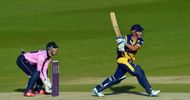
Wides and No-Balls
The wide is another rule that works on the judgement of the umpire. We may see lines that act as guidelines for the umpires on deciding whether a particular delivery is legitimate or not. However, contrary to popular belief, they are not strictly to be followed.
As an example, if a batsman shuffles and takes guard on his off stump, the wide (an imaginary line) shifts from it’s usual position and moves further away from the batsman. But this is not the case if the batsman shuffles after the delivery has left the bowlers’ hand. In this case, the original line shall continue to act as the guideline.
Speaking of reverse sweeps and switch hits, there is one major difference between the two is that in case of a reverse sweep, the wide guidelines remain unaltered. This means that if the delivery will be called wide only if it is a wide in the normal course of action.
However, in case of a switch hit, both the wide lines now become ‘off wides’. This means that even if the ball is sprayed down the (original) leg side but it is within the ‘off-wide’ line, it shall be a legitimate delivery.
Similarly, speaking of no-balls, we often tend to think that a ball is not a no-ball for height if the batsman is outside the crease. The rule, though correct at a time has been altered since and according to the current rules, the ‘point of impact’ has to be considered. This means that regardless of where the batsman is standing when he plays the ball, if it is over the waist is shall be called as a no-ball for height.
Looking for fast live cricket scores? Download CricRocket and get fast score updates, top-notch commentary in-depth match stats & much more! 🚀☄️
